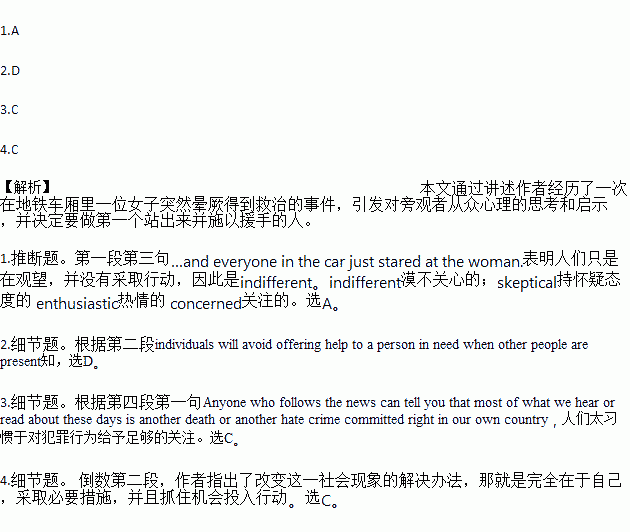题目内容
The American Bystander
On a humid subway ride into work a few days ago, a woman on the other end of my car had a seizure (病情突然发作). All of a sudden, I heard her let out a painful sigh as she collapsed. For several minutes, the train continued down the track, and everyone in the car just stared at the woman. Finally, at the next stop a man informed the operator of what had happened and called 911. Luckily the woman came to herself as the EMTs carried her off the train. Ever since, I’ve been puzzled by the same question — why didn’t anyone do anything? And more importantly, why didn’t I do anything?
We’ve learned about the commonly referenced bystander effect—a psychological phenomenon in which individuals will avoid offering help to a person in need when other people are present. The bystander effect is attributed to two different psychological processes: social influence—individuals in a group will monitor and imitate other group members’ behavior—and shift of responsibility—individuals will cease to help because they believe that someone else will.
Even though most people probably haven’t witnessed a woman having a seizure on the subway, I’m sure if asked, anyone could think of a time when they could have helped and simply didn’t. In fact, I know that we have all experienced the bystander effect, because I believe it is one of American society’s most common headaches.
Anyone who follows the news can tell you that most of what we hear or read about these days is another death or another hate crime committed right in our own country. Consider the most recent theatre shooting in Nashville. The headlines read Another Theatre Shooting, Gunman is dead. When we read that headline or heard it on the news, most of us just acknowledged how sad it was, then told ourselves that there is nothing we can do to help and assumed that someone else would.
If America is just one large group of witnesses, all while telling ourselves that someone else most certainly will step in, how can we hope to shake the hold of this social psychological spell? The solution lies solely within us, to know the difference between doing what is justifiable and doing what is right, helping those in need when we have the means and opportunity to do so.
I want to be like the man on the subway who told the operator about the woman’s seizure, because as soon as he did, people followed suit and offered help. We have the power to choose whether to justify passivity or actively decide to do the right thing, and as a society I believe we ought to break free from our psychological tendency to just stand by.
1.What was the most passengers’ attitude towards the woman’s seizure?
A. Indifferent. B. Skeptical.
C. Enthusiastic. D. Concerned.
2.The psychological explanation for the fact that most people hesitate to help is that ________.
A. they need heroes or good examples to learn from
B. they believe such cases are none of their business
C. they fear that their behavior will be imitated by others
D. they count on other group members to give a helping hand
3.What can we learn from the theatre shooting in Nashville?
A. The mass media are only too concerned about crimes and deaths.
B. The majority of the US citizens are suffering from crimes.
C. People get too accustomed to pay adequate attention to crimes.
D. Media coverage is inconsistent with what the Americans assume.
4.As far as the author is concerned, the key to solving such an effect lies in ________.
A. the necessary means and opportunity to help others
B. the essential power to display psychological tendency
C. the acute awareness of making a right choice
D. the determined effort to help whoever is in need of help
 宝贝计划期末冲刺夺100分系列答案
宝贝计划期末冲刺夺100分系列答案 能考试全能100分系列答案
能考试全能100分系列答案
